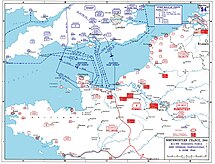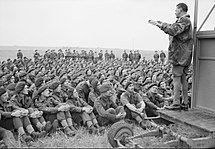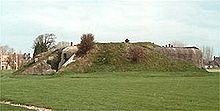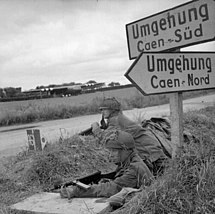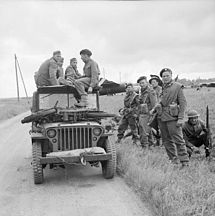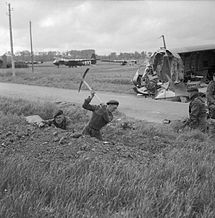Operation Tonga
| date | June 5. bis 6. June 1944 |
|---|---|
| place | Normandy , France |
| output | allied victory |
| Parties to the conflict | |
|---|---|
| Commander | |
|
Dietrich Kraiss |
|
| Troop strength | |
|
6th Airborne Division 3rd Division 1st Special Service Brigade |
711th Infantry Division 716th Infantry Division 352nd Infantry Division 12th SS Panzer Division "Hitler Youth" 21st Panzer Division |
| losses | |
|
When conquering the bridges: 2 dead, 14 wounded (after the first day) , When the Merville battery was destroyed: 65 dead, 30 wounded, 22 prisoners |
not exactly known |
The Operation Tonga in World War II was part of the British landings in Normandy and part of Operation Overlord or part of Operation Neptune . Operation Tonga took place on June 5, 1944. The British 6th Airborne Division landed in the course of the operation with gliders and parachutes in the part of Normandy behind the Sword stretch of beach in order to take the Pegasus Bridge and the Horsa Bridge, to keep German armored units off the beach and an artillery battery at Merville and German supply routes (the bridges via the Dives and the Divette).
The Allies were able to successfully capture and hold the key bridges (Pegasus and Horsa Bridge), destroy the artillery battery at Merville and the supply routes. Operation Overlord and D-Day succeeded in gaining a foothold on the beaches and creating a solid base in France for the reconquest of Western Europe.
The fighting around the Pegasus Bridge were later the non-fiction book by Cornelius Ryan ( The Longest Day: June 6, 1944 ) describes the later under the name of The Longest Day (German The Longest Day ) was filmed. Computer games also took the battles over the Pegasus Bridge as a model.
initial situation
In order to relieve the Red Army , Stalin had urged the Western Allies to open a second front , especially since the British and American landing in Italy in 1943 did not bring the desired quick success. At the Tehran Conference in November 1943, Roosevelt , Stalin and Churchill agreed on a landing operation, code-named Operation Overlord, to recapture northern France, including Paris, via the English Channel . This should take place in Normandy between the cities of Cherbourg and Le Havre . At the Casablanca Conference , the founding of a combined headquarters, the Supreme Headquarters Allied Expeditionary Force , was decided, which the Supreme Allied Commander Dwight D. Eisenhower took over. Eisenhower's chief of staff was named Chief of Staff to the Supreme Allied Commander , Lieutenant-General Frederick E. Morgan , who directed the planning for Operation Overlord. Bernard Montgomery took over the management of the landing units . The naval forces would be commanded by Admiral Bertram Home Ramsay , while the air forces would be led by Air Chief Marshal Trafford Leigh-Mallory .
The first phase of Operation Overlord, the formation of a beachhead on the beaches of Normandy, was code-named Operation Neptune . This operation was divided into several sub-operations of the participating troops, including Operation Tonga. To secure the flanks of the bridgehead initially formed by five infantry divisions, the British 6th Airborne Division (Operation Tonga) to the east of the landing beaches and the US 82nd and 101st US Airborne Divisions (Operations Detroit and Chicago) to the west . Operation Neptune also included securing the landing fleet and bombing the German coastal positions by air and naval forces.
planning
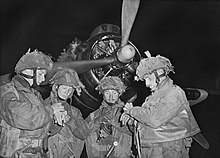
Shortly after it was clear that the British 6th Airborne Division would take part in the invasion, Major-General Richard Gale and his staff arrived at the headquarters of the 1st Corps in London to take the orders. A plan was drawn up that hardly changed in the months that followed.
Since the entire division could not be flown in due to capacity problems, it was decided to fly in first a small part of the division and later the second, large part. The code name Operation Tonga was chosen for the first landing, which was to take place some time before the landings on the beaches . The second approach was supposed to take place on the evening of D-Day and was named Operation Mallard . During Operation Tonga, key bridges were to be taken and some other bridges and objects destroyed. The conquered areas were to be held until the rest of the division secured the area in the course of Operation Mallard and reinforced the units that had already landed.
In addition to the transport capacity, it was also problematic that the Germans protected parts of the site from glider landings with wooden stakes. Furthermore, they had flooded large parts of the area around the Dives and Divette rivers, which were threateningly close to jump zone V (AZ-V).
Operation Tonga
Conquering the Pegasus and Horsa bridges
The D company of the 2nd Battalion of the Oxfordshire & Buckinghamshire Light Infantry Regiment of the British 6th Airborne Division under Major John Howard was to land in the area of operations on the night of June 5th to 6th, key bridges - the Benouville Bridge over the Caen Canal and the Horsa Bridge over the Orne - take and hold, and wait for the main British unit to advance from Sword .
In a parachute landing, all units would likely have been scattered across the area and would have had to gather first. Since this was rejected as unacceptable with regard to a possible early detection of the units, the only alternative was a coup d'état . In order to be able to land surprisingly quickly with a sufficient number of soldiers as precisely as possible at the targeted object, six cargo gliders of the type Horsa were chosen as the means of transport. Each glider could accommodate a fully equipped platoon that would be ready for action immediately after landing.
Howard's men, including pioneers, were supposed to land very close to the bridges in order to then storm the bridges with the help of the surprise effect. When that was done, the pioneers should remove the explosives that the Germans had attached to the bridge's counterweight.
For this part of the operation, models of the bridges and the surrounding area were recreated based on aerial photographs from the Royal Air Force and reports from French resistance fighters . Major John Howard, charged with capturing the bridges, prepared himself and his men extensively for Operation Tonga.
In the course of the fighting, scouts and smaller paratroopers were supposed to land in landing zones K, N and V. Their task was to secure the surroundings and to set up the "Eureka" signal lights, which were used to determine the position of the main units that were flying in for half an hour.
The 5th Paratrooper Brigade was assigned to Landing Zone N north of Ranville . It should form a locking position around the bridges. To this end, the 7th battalion had to secure west over the Orne and the towns of Bénouville and Le Port, while the 12th and 13th battalion should conquer Ranville and a hill south of it.
Capture and destruction of the Merville Battery
In a further partial operation, the artillery battery near Merville was to be captured and destroyed. The 9th Battalion under the command of Lieutenant-Colonel ( Lt. Col. ) Terence Otway should run this command.
The battery could cause considerable damage to the troops landing on the beach and the landing craft with its four cannons. According to the Allies, the most effective way of eliminating this threat was an airborne strike . The British assumed that there were four 150 mm howitzers in the battery , each of which was in turn located in an approximately 1.80 m thick concrete casemate , which had a steel door at the front and back.
The protection of the Merville battery was considerable. An anti-tank ditch more than 360 meters long, 4.5 meters wide and three meters deep, surrounded the battery on the west and northwest sides. In addition, two rows of barbed wire were laid out, the first of which was relatively harmless, but the second was almost two meters high and three meters wide. There was a minefield between them. In addition, other mines were laid out on possible approaches to the position. The battery or the position system around it was occupied by 160 German soldiers. The close-range safety of the battery was spread over approx. 15 to 20 positions and shelters, each of which was equipped with approx. There were also three 20 mm anti-aircraft guns, which could be used against air targets as well as in ground combat. However, the Germans had little ammunition as supplies had been destroyed by the Resistance and allied bomber units. The battery command post was about two kilometers north, near the Sword stretch of beach.
The 9th Paratrooper Battalion was scheduled to land in Zone V, a field about two kilometers from the battery. Before that, the C Company of the Canadian 1st Paratrooper Battalion was supposed to capture and secure the landing zone. Scouts from the 22nd Independent Parachute Company should then mark the landing site to guide the main wave of bouncing. The A Company of the Canadian 1st Paratrooper Battalion was designated to protect the left flank of the 9th Paratrooper Battalion as they advanced to the battery and led the attack. Between 0:30 a.m. and 0:50 a.m., around 100 Royal Air Force Avro Lancaster bombers were supposed to prepare the target with 635 tons of bombs ready for attack.
The 9th Paratrooper Battalion had rehearsed the attack under Otway with 650 to 785 men, most of whom were between 18 and 20 years old, on a 1: 1 dummy of the battery in West Woodhay, 11 kilometers southwest of Newbury in England , so that every soldier knew exactly what to do. Several groups had been formed to carry out the preparatory tasks. There was a rendezvous group scheduled to jump at 12:20 a.m. to rally the battalion to the landing area. With them a reconnaissance group ( Troubridge ) was planned to jump, which should advance to the battery as quickly as possible, spy on everything there, meet the battalion and inform the commanding officer of their findings. The next step was to brief the unit on the Merville battery in the best possible way.
The main part of the battalion was to jump off at 12:50 a.m. First should be a part of mine detectors , the minefields scan up to the main fence and clean and then identify a safe path through the minefield with ribbons. Almost an hour and a half was given for grouping, etc., so the attack should start at 2:35 a.m. The battalion was to assemble for the attack at a predetermined position, approximately 500 yards from the battery, between 4:10 and 4:20 a.m. With three Horsa gliders, the A company and about 591 pioneers who carried the explosive charges were to be deposited inside the battery. A mortar should fire on the battery. After two and a half minutes, an audible signal should cause the fire to be stopped for distraction everywhere except the main gate. Another two minutes later, at 4:30 a.m., when the first glider was due to land, the bugler was to sound another signal to end the mortar bombardment. Then the attack should begin. B Company was supposed to blow up the fence, whereupon C Company had to attack.
If Otway's troops did not give a signal of success by 5:30 a.m., HMS Arethusa should open fire on the battery.
Destruction of the bridges over the Dives and the Divette
The bridges over the Dives and the Divette were to be destroyed in a third partial operation by the Canadian 1st and British 8th Battalions so that the German troops behind them could no longer pose a threat to the invasion troops who were to land on the Sword beach section .
After the blasts had been carried out, the order was to withdraw and hold the important elevation that extends from the Bois de Bavent, four miles southeast of Ranville, to the towns of Le Plein and Le Mesnil, two miles north and east of Ranville.
The further procedure
Now that the division secured the eastern flank of the Normandy invasion, the sea landings on Sword Beach could begin at 7:30 a.m. at dawn on June 6th. According to plan, the troops under Lord Lovat should arrive in Bénouville around noon and then cross the bridges to the east into the division perimeter. Subsequently, the conquest of the northern sector of the hill was planned, as well as the cleaning of the coast between Sallenelles and Franceville Plage.
Operation Mallard
On the evening of June 6, 1944, most of the British 6th Airborne Division with equipment, weapons and ammunition supplies, including light tanks and an artillery battery, was to land with gliders in landing zones N and W and secure and reinforce the conquered areas. Although two approach waves were planned, this still exceeded the transport capacity as not so many gliders were available. Parts of the division had to be brought to Normandy by sea the following day .
Planning obstacles
In the course of the next few months after the operations had been planned, the British secret service noticed increased German activities on the Normandy beaches and their hinterland. In particular, they noted that long metal poles and tree trunks were erected in open space suitable for parachute and glider landing. After initially assuming that the Normandy invasion plan had been exposed, the secret service found that such actions were carried out throughout northern France and were not limited to Normandy. In spite of everything, the piles, which were later called " Rommel asparagus ", represented an enormous danger for the air landings, especially since some were additionally secured with mines. It was therefore decided to let the pioneers of the 591st Paratrooper Squadron jump with them to accompany the first wave so that they could clear the landing zones for the gliders from the obstacles.
Another worrying aspect was the recently flooded areas in the hinterland, which also posed a fatal threat to the parachute units. Some of these areas were also very close to jump zone V, where the main landing of the 3rd Parachute Brigade was to take place.
German associations
The area of operations was directly on the border of the operational areas of the German 7th Army and the German 15th Army . The Allies chose this area because they hoped that there would be confusion about jurisdiction and no regulated counterattack would be possible. The German associations were all spread over a relatively wide area.
The main German force, which was supposed to repel an invasion, was concentrated in the area on the Strait of Calais , since there the distance from England to France is the smallest. These assumptions were reinforced by the Allied deception operation Fortitude .
The Germans suspected that the Allies would attack during the day and in good weather, as had been observed in previous Allied invasions. Since bad weather had been forecast for June 5th and 6th, 1944, many generals were absent. Some, such as B. the commander of the 7th Army , Colonel-General Friedrich Dollmann , stayed at a war game in Rennes . The commander of the German troops in Normandy, Field Marshal Erwin Rommel , visited his wife in Germany on June 6, as she was celebrating her 50th birthday.
The three German infantry divisions in this area, the 352nd , 711th and 716th Infantry Division , as western divisions with inadequate equipment and lower actual strength than large immovable formations, did not pose too great a threat to the British 6th Airborne Division. The well-equipped 12th SS Panzer Division "Hitler Youth" , under the command of SS Brigade Leader Fritz Witt, and the 21st Panzer Division , which had been under the command of Lieutenant General Edgar Feuchtinger since May 8, 1944 , each had Evidence of military strength over a target strength of approx. 20,000 soldiers - but can prevent the success of the operation. The 12th SS Panzer Division "Hitler Youth", mostly made up of 17-year-old members of the Hitler Youth , could have reached the area affected by Operation Tonga in about twelve hours. The 21st Panzer Division was south of the city of Caen and was therefore a great danger to the Allies.
execution
Conquering the Pegasus and Horsa bridges
In the last hours of June 5, 1944, Howard's units, D Company, parts of B Company and some pioneers started to landing zones X and Y (LZ-X; LZ-Y). In six of Halifax bombers towed Horsa gliders were Howards transported troops. Over the coast of Normandy, east of Merville, the gliders were released at an altitude of 1900 meters. The Halifax bombers continued to fly in the direction of Caen to bomb a cement factory there as a diversion. At around 12:16 a.m. (UK time), Howard's glider landed 47 meters away from the bridge over the Caen Canal, the Pegasus Bridge , as it would later be called. During the crash landing, however, the aircraft crashed into a rock, which severely damaged the aircraft (especially the cockpit), injuring many soldiers slightly or losing consciousness for a short time, and the two who flew the glider flew through the cockpit window, but survived it with some injuries. Another glider, at the helm Staff Sergeants Boland and Hobbs, with 28 soldiers on board, landed right next to Howard's glider at 12:17 a.m., while a third (at the helm, Staff Sergeants Barkway and Boyle) landed near them at 12:18 a.m. both landed, but broke and slid into a pond. Two soldiers were seriously injured and lost consciousness. One of them, Lance Corporal Fred Greenhalgh, eventually drowned in the swampy water. However, the German troops guarding the bridge did not react to these landings, either because they did not notice them or because they believed it was a plane crash.
The British attacked the bunker on the east bank of the river , which contained a machine gun emplacement, by throwing hand grenades into it. The men then stormed the bridge. On the other side, Lieutenant Den Brotheridge threw a grenade into the bunker there. The next moment Brotheridge was fatally wounded by a shot in the neck. He is considered the first Allied soldier to be killed by enemy hands on D-Day . When the first train attacked the bridge, the second glider landed on board with the second train and came to the aid of the first train. The crew, who managed to free themselves from the skimmer slid in the pond, advanced under Lieutenant Smith to the west side of the bridge. The pioneers then removed the explosive charges on the counterweight of the bridge, which secured it.
At about 12:22 a.m., the other group of three began approaching the Horsa Bridge . But one of the three gliders landed eight miles from the designated landing zone, near the dives. During the day, this part of the British fought their way to Howard's troops, killing four men. At around 12:26 a.m., both bridges were finally secured. At about 0:30 am, the injured pilots of the lead pilot, Staff Sergeants Wallwork and Ainsworth, regained consciousness, searched the aircraft for working weapons and ammunition, and took them to their comrades.
At 1:40 a.m., the Germans launched their first counterattack with a tank from the 21st Panzer Division . But the British noticed this early on and took position. They lured the Germans into an ambush. Sergeant Charles Thornton had the Piat anti-tank weapon ready . The shaped charge projectile hit the ammunition store, whereupon the entire tank exploded. The Germans withdrew because they suspected there were more such weapons, but on the contrary, the British only had one bullet left. They successfully defended the bridge and fought back counter attacks, including by some snipers, and also captured the German bridge commander, Major Hans Schmidt .
At around 8:30 a.m., the British flew over the bridges in two Spitfire fighters to check their condition. They also dropped the London morning paper. Then they turned off again. When the Germans realized that they had no chance of driving the Allies out of France, they now pursued the plan to destroy the bridges. For this they mobilized one of only a few Focke-Wulf 190 . Armed with a 250 kg bomb, she launched an attack. The bomb hit the bridge but did not explode. It ricocheted off her and fell into the Caen Canal .
The task of subsequent reinforcements was to launch an unprotected counterattack on the German 21st Panzer Division in order to prevent them from advancing onto the beaches of Normandy. When the troop transport gliders appeared over the heads of the German tank commanders, they thought they were completely cut off and withdrew their units.
Howard's unit was one of the first to land in Normandy. Two of the 181 soldiers of the D Company were killed while conquering the bridges, and another 14 were wounded. At noon on June 6th, at around 1:30 p.m., the 1st Special Service Brigade under Lord Lovat pushed forward to Howard's troops.
Although the landings were rehearsed successfully, many units were dispersed in Normandy .
Capture and destruction of the Merville Battery
Otway's troops were scattered across the area. Only about 150 of the men had gathered at the agreed meeting point at 2:50 a.m. In addition, the jeeps , armor-piercing weapons, mortars , minesweepers , paramedics and the pioneers did not reach the meeting point. They gathered near Gonneville-sur-Merville , where they on bombers of the Royal Air Force were waiting, the Merville- battery destroy or damage should, at least. However, the bombers missed their target and instead hit Gonneville, causing a mess among the British paratroopers.
One of the British gliders was shot down by a 2 cm anti-aircraft gun, which, however, distracted the Germans from a small force around Otway. Otway decided, despite the fact that he had far fewer resources than planned, to attack the battery with his men. Soldier Alan Jefferson said of Otway, “I saw Colonel Otway's look. It looked like it had been taken straight out of the freezer, completely rigid and white and it was visibly uncomfortable. " Otway later said, " I had a choice: give up or attack. But how would you have stood in front of your friends? I didn't want people to say he gave up. So I decided to attack. "
The minesweepers defused the mines in the minefields without their special tools because they had not received their equipment, whereupon Otway's force cut the barbed wire surrounding the battery. Now they attacked the battery from behind. The paratroopers had to improvise because they lacked the explosives.
The commander of the German garrison , Raimund Steiner, a telephone operator, radio operator and surveyor, was in the command post about two kilometers away, from where he was watching the English Channel. The British and Canadians stormed the casemates and took the Germans by surprise. After Steiner heard about the attack by phone at around 4 a.m., he ordered the men he had left to retreat to the command bunker and to hide there. On the phone he heard how the soldiers under his command were fighting to death because of the phosphorus thrown inside by the British . The battle between Otways and Steiner's troops lasted about half an hour.
Otway had the guns destroyed and radioed to HMS Arethusa that they had done their job. The British left the battery again, whereupon the surviving Germans came out of their hiding places to recapture the battery. The British attacked the battery again with fire support from HMS Arethusa in order to finally take it, which they succeeded.
At around 5 a.m. the battery was in British hands. 65 British paratroopers were killed, 30 more wounded and 22 captured. 190 more are still missing today. After the fighting ended, it turned out that the cannons were not 150 mm, but 100 mm howitzers and would have posed a far less threat to the landing forces.
Destruction of the bridges over the Dives and the Divette
The Canadian 1st Paratrooper Battalion had several tasks to do after the landing.
The A Company was designated as the left flank protection of the 9th Battalion at the Merville Battery, but after landing they first had to cross the town of Gonneville-sur-Merville. Once there, she sought cover as quickly as possible because the Royal Air Force was bombing the village. Shortly afterwards they were shot at by a small group of Germans from a château . The attack on the château then carried out by the company was successful, as was the flank protection for the attack on the Merville battery. The A Company then covered the retreat of the 9th Battalion and then advanced on Le Mesnil , where the other Canadians gathered.
Company B was assigned to accompany the pioneers of the 3rd parachute squadron, which was supposed to destroy the bridge at Robehomme . However, three of the four trains landed two miles from their landing zone in the areas flooded by the Germans and first of all fought against drowning. The 5th platoon, led by Lieutenant Toseland, landed on solid ground and was led to the bridge by a French woman they had met en route. On their way, more and more men from the 3rd Paratrooper Brigade joined them, including soldiers from the 8th Battalion, which should have landed seven miles away. Major Fuller, in command of B Company, was waiting for them at the bridge. However, the explosives necessary for the destruction had not arrived. A sergeant improvised by collecting more than 13 kilograms of explosive material from the small bombs he was carrying and attempting to blow up the bridge. It was seriously damaged in the process, but not destroyed. Around 6:00 a.m., some pioneers reached the bridge with explosives that had been collected along the way. These more than 90 kilograms were then sufficient to destroy the bridge.
The men of C Company were the first Canadians to reach French soil. You should land with the scouts about half an hour before the main force almost exactly in the landing zone DZ-V. The reason for the earlier jump was the task of taking a German headquarters near the landing zone and then moving on to Varaville . There the bridges over the Divette should be destroyed and the place itself should be taken.
The already widely scattered jumps reached a climax with Lieutenant Madden and half of his platoon right at the beginning of the invasion , as their pilot accidentally mixed up the Orne and Dives rivers, so that the soldiers found themselves on the wrong side of the wrong river . They were more than a mile from Sword Beach. Other paratroopers were set down more precisely, so that after a ten-minute wait, Major McLeod had already assembled 15 soldiers at the assembly point. Just as he was about to send his little unit on its way to Varaville, the RAF bombers attacked the Merville battery. Some of the pilots ruthlessly dropped their unused bombs over the DZ-V landing zone, which gave some soldiers a real shock.
On the way, Major McLeod was able to pick up more soldiers from his and other units and reach the village undetected. As they were preparing for the attack, however, they were spotted and shot at from a high 75mm infantry gun. One hit went into an ammunition box and killed one of the Canadians. Major McLeod was seriously injured. The following fight lasted until 10:00 a.m. The German garrison , which had now shrunk to 46 men , then surrendered. An hour earlier, Lieutenant Baille and his pioneers had managed to destroy the bridge.
The soldiers of the 8th Battalion, who had landed seven miles to the west, had great difficulty getting back together because they had landed over a large area. In addition, the scouts for DZ-K accidentally jumped off at Ranville, four miles north, so that 14 of the 37 Dakotas dropped their paratroopers over DZ-N.
By 3:30 a.m., only 141 men had reached the assembly point. With this force, Lieutenant Colonel Alastair Stevenson Pearson advanced on Troarn . To cover his back, he posted two anti-tank guns on the road to intercept enemy units from the west. A few hours later this group destroyed six vehicles of the German 21st Panzer Division. Since the 8th Battalion was not yet strong enough to attack Troarn, they stopped a mile north of the town at a crossroads. A small group of the 3rd Paratrooper Squadron was ordered to destroy both bridges over the Dives near Bures , which they successfully carried out around 9:15 a.m.
Major John Couch Adams Roseveare , the commander of the 3rd Paratrooper Squadron , who did not know the situation of the 8th Battalion, was at the time with a jeep and some of his men on the way to Troarn. They drove straight through the town, drawing fire to the German garrison, which now knew that something must have happened. The Canadians returned fire from the fast moving jeep and got away with all but one man. Sergeant Peachey, sitting in the trailer, was thrown out of the vehicle in a curve and was taken prisoner by the Germans shortly afterwards. Roseveare and his men reached the bridge behind the town. They attached the explosive charges and at 5:00 a.m. they were able to blow a hole about six meters in diameter in the bridge.
The 8th Battalion had not noticed any of this and continued to prepare for the attack on Troarn. In the course of time more and more reinforcements arrived, like half of A Company and most of the mortars and light machine guns . When the group from Bures arrived again, Pearson sent them and another group to Troarn to establish a defensive position in the forest even with the main force. The forest formed the southern boundary of the hill that the 3rd Parachute Brigade was supposed to defend. The two groups were shot at twice by German outposts on their way, but after brief negotiations they gave up and were captured. When they arrived at the bridge, they found that it had already been damaged by Roseveare. Nevertheless, they also attached their loads and thus doubled the damage to the bridge.
German reactions
The SS Panzer Divisions, including the 12th SS Panzer Division, could only be set in motion with Adolf Hitler's permission . But since he was asleep, the division stayed where it was stationed and did not intervene in the fighting. The fighting was downgraded by the Germans as an attempt to deceive the actual invasion of the Strait of Calais . Since the Resistance had destroyed the telephone and telegraph lines, there was little information available from the Germans about the Allied troop movements. The Allies also dropped dolls in paratrooper uniforms , which they called Rupert and which imitated loud fighting noises, over Normandy. Since, in addition to these imitations, six SAS soldiers jumped off and repeatedly carried out mock attacks on German positions, the Germans were completely confused and unable to act sensibly.
In order to disguise an air landing, Allied aircraft dropped bombs on various targets in the operational area. Additional confusion arose from the accidental jump of a number of Allied paratroopers over the wrong area, so that they had to break through to their units and attack various German units. As a result, the German forces were diverted from the actual operational areas and ordered their local forces into the wrong operational areas.
Although the German commanders realized that an invasion was taking place, they and the then Commander-in-Chief of the Wehrmacht thought it was a ruse and suspected that the main invasion would take place in the area of the Strait of Calais. Some still expected a major invasion at this narrowest part of the English Channel months later.
aftermath

Operation Tonga was a complete success for the Allies. The units were able to successfully hold all key bridges and destroy all intended targets. The other Allied operations in Normandy were also relatively successful, so that the Allies were able to gain a foothold in Normandy. With constant supplies they were able to expand the bridgeheads and gradually penetrate deeper into France. The British Air Chief Marshal (Air Marshal) Trafford Leigh-Mallory described the landing at the Pegasus Bridge and Horsa Bridge as "one of the most outstanding flying achievements of the war." (German: "one of the finest flying performance of the war." ).
The battle for the Pegasus Bridge became one of the most famous events of the Allied invasion of Normandy. Many films, books or other media processed the battle for the Pegasus Bridge, for example the feature film The Longest Day .
The Benouville Bridge was officially renamed the Pegasus Bridge after it was captured by the Airborne Division. When the traffic on the road over the bridge increased after the Second World War, the old bridge was replaced by an enlarged copy of the original construction - in order to preserve the overall historical impression. The original bridge is now part of the Pegasus Bridge Museum. In addition, the street over the Pegasus Bridge was renamed "Major Howard Avenue" in Howard's honor .
John Howard was awarded the Distinguished Service Order on July 16, 1944 by Field Marshal Montgomery . Many other soldiers of the British 6th Airborne Division also received awards such as the Distinguished Service Cross or the Order of the British Empire .
The former artillery battery near Merville can be visited by tourists. A small museum is now housed in one of the old, preserved bunker buildings of the Regelbau 611 type , Casemate No. 1. In front of the grass-covered battery is a small memorial to the British 9th Battalion and a memorial stone with a bust depicting Colonel Otway.
Processing
Movies
- The 1962 feature film The Longest Day , produced by Darryl F. Zanuck , recreates the capture of the Pegasus Bridge under the command of Major John Howard (played by Richard Todd , who participated in the operation as a young soldier). The capture of the bridge is shown in the film much more spectacularly than it actually was. So there was no major battle on the bridge. The film is based on the non-fiction book of the same name by Cornelius Ryan . The film also shows other parts of the Allied landing in Normandy. ( FSK : 12)
- The documentary film D-Day 6/6/44 - Decision in Normandy by the British television broadcaster BBC also documents the events during the attack on the Merville battery. Producer: Tim Bradley ; Directed by Richard Dale , Kim Bour , Pamela Gordon , Sally Weale . ( FSK : 16)
Games
- Call of Duty : Computer game by the US game developer Infinity Ward , which was published by Activision in autumn 2003 , in which the British Sergeant Evans reenacts the attack on the Pegasus Bridge. ( USK : 18)
- D-Day : In this real-time tactical computer game, the player can re-enact the attack on the Pegasus Bridge and the artillery battery near Merville. There is also information and levels etc. about other events around D-Day. (USK: 16)
- Day of Defeat : Computer game online multiplayer add-on for the first-person shooter Half-Life , which is also set in occupied France. However, there is no more detailed information about the backgrounds.
- Codename: Panzers (Phase One): Computer game deals with the capture of the Pegasus Bridge in the first mission of the Allied campaign ( USK : 16)
literature
- Jon Cooksey: Operation Tonga: Pegasus Bridge and the Merville Battery , Pen & Sword Books, 2005 (not yet published), ISBN 1-84415-203-0 .
- Dan Parry: D-Day , 2004, ISBN 3-8025-1618-4 .
- Tony Hall: Operation "Overlord" , Motorbuch Verlag, 2004, ISBN 3-613-02407-1 .
- Dan van der Vat: D-Day , 2004, ISBN 3-89910-199-5 .
- Will Fowler: D-Day: The First 24 Hours , Amber Books Ltd., London, 2003, ISBN 3-85492-855-6 .
- Neil Barber: The Day the Devils dropped in , Pen & Sword Books Ltd., 2002, ISBN 0-85052-924-7 .
- Kevin Shannon, Steven Wright: One Night in June (Airlife Classics) , The Crowood Press, 2000, ISBN 1-84037-183-8 .
- Helmut K. von Keusgen: D-Day 1944, The Landing of the Allies in Normandy , 2000, ISBN 3-932922-10-7 .
- Christopher Chant: Operation Overlord: Sword Beach and the British 6th Airborne Division, 6 June 1944 (Ravelin's Order of Battle S.) , Ravelin, 1994, ISBN 1-898994-00-5 .
- Stephen Ambrose: Pegasus Bridge: June 6, 1944 , Simon & Schuster, New York, 1985, ISBN 0-671-52374-0 .
- Norbert Hugede: The Commando of the Pegasus Bridge , France, 1985.
- Cornelius Ryan : The Longest Day: June 6, 1944 , Simon & Schuster, New York, 1959, ISBN 0-671-89091-3 .
- Denis Edwards: Devil's Own Luck: From Pegasus Bridge to the Baltic , 1999, ISBN 0-85052-667-1 .
- Carl Shilleto: Pegasus Bridge & Merville Battery: British 6th Airborne Division Landings in Normandy D-Day 6th June 1944 , Pen & Sword Books, 1999, ISBN 0-85052-642-6 .
- Richard Gale : With the 6th Airborne Div in Normandy , Sampson Low, Marston & Co, London, 1948.
- Sir Napier Crookenden: Dropzone Normandy: The Story of the American and British Airborne Assault on D-Day 1944 , Ian Allen, 1976, ISBN 0-684-14595-2 .
- John Golley: The Big Drop , Kensington Pub Corp (Mm), 1986, ISBN 0-8217-1867-3 .
- Alan Jefferson: Assault on the Guns of Merville , John Murray, 1987.
- Public Records Office: 9th Battalion War Diary
Web links
General
- ornebridgehead.org (English)
- Information on the operation (English)
- Link collection ( english )
- Comprehensive information ( Memento from November 21, 2007 in the Internet Archive )
Pegasus and Horsa Bridge
- Pegasus Memorial website (English / French)
- Information on the storming of the Pegasus Bridge (English)
- Photo material u. a. to the Pegasus Bridge (English)
- History of the Pegasus Bridge ( Memento from March 20, 2008 in the Internet Archive )
Merville battery
- Stern article on the Merville battery
- Storming of the battery at Merville (English)
- Attack on the battery at Merville (English)
- The Battery at Merville (English)

